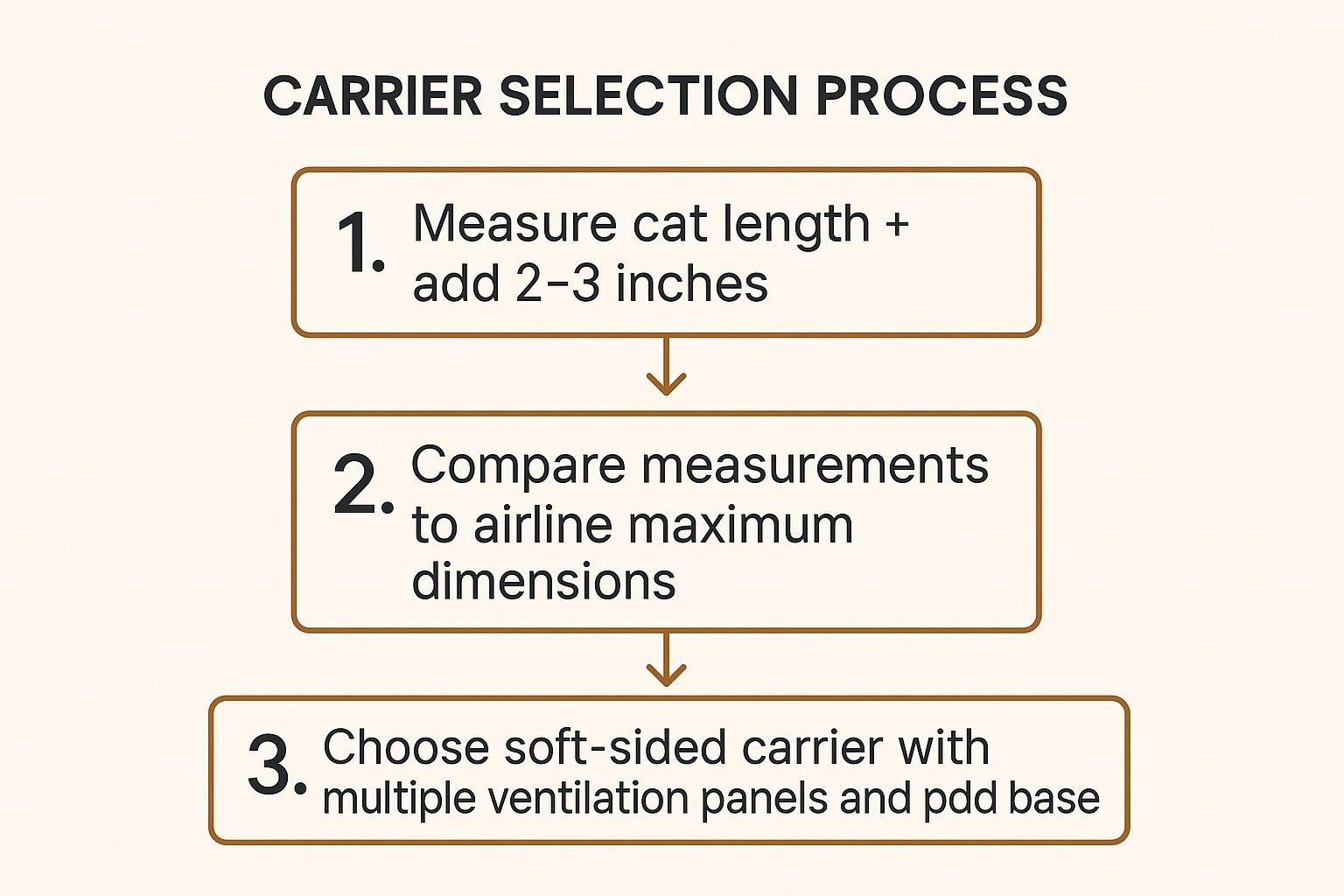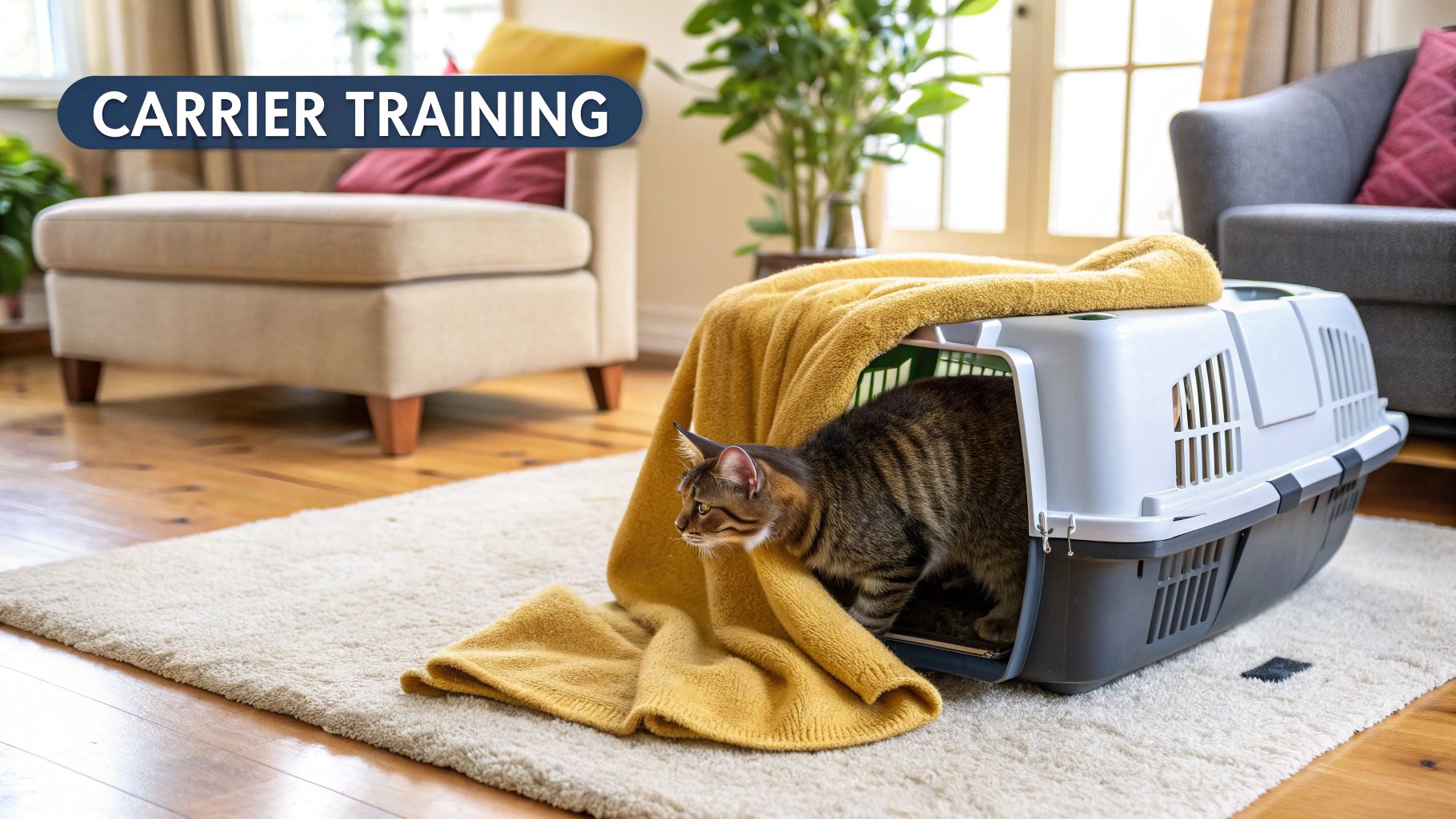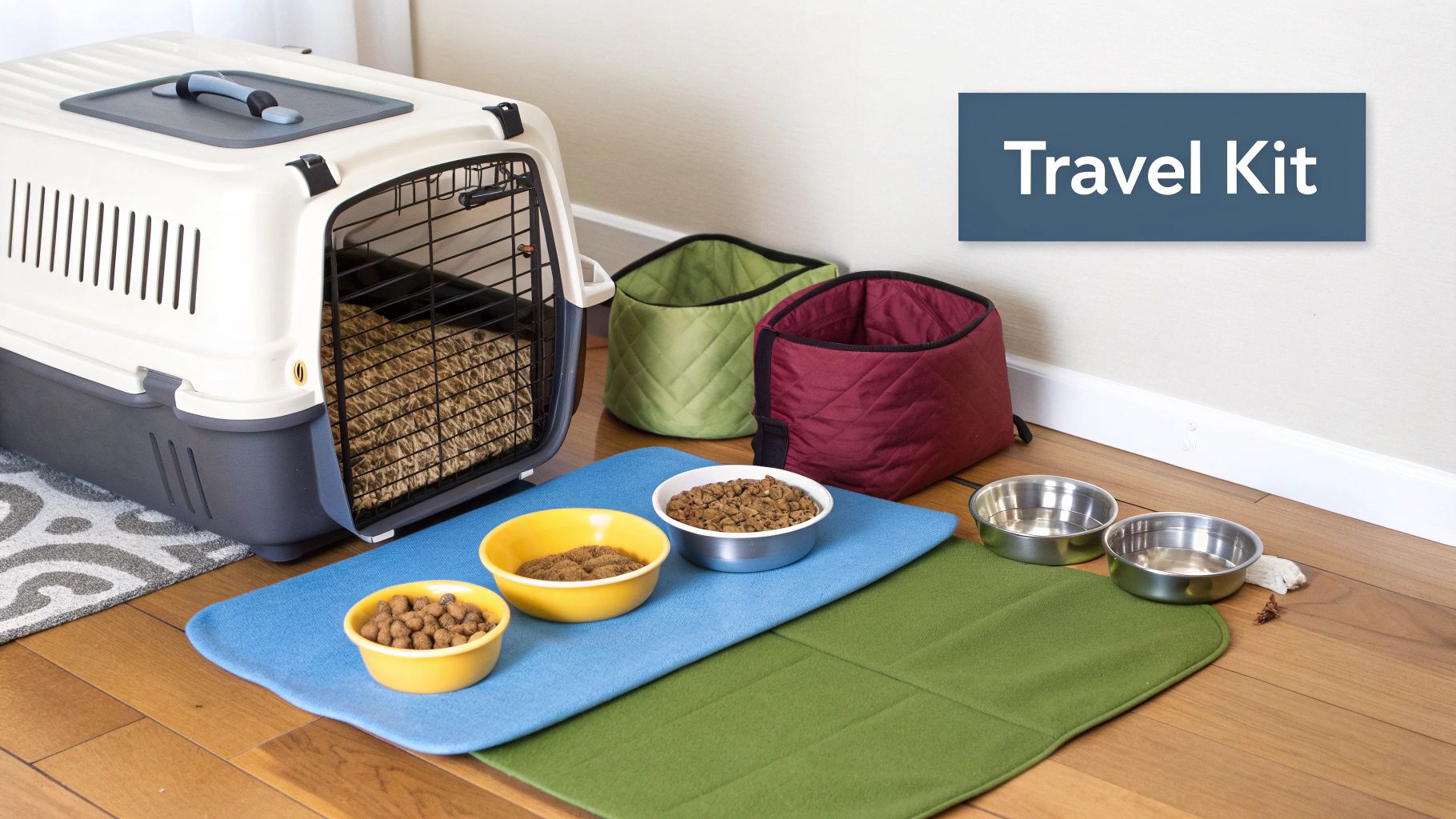Traveling with a feline companion can seem daunting, but with the right preparation, flying with your cat can be a smooth and manageable experience. Many cat owners worry about their pet's comfort and safety in an unfamiliar, noisy environment. The stress of navigating airline regulations, security checkpoints, and the in-flight environment is a valid concern. However, a successful journey is entirely achievable through careful planning and foresight.
This comprehensive guide is designed to eliminate the guesswork and provide actionable tips for flying with a cat. We will walk you through every critical step, from the initial stages of selecting the perfect airline-approved carrier and navigating complex policies to ensuring your cat's well-being on travel day. We will cover crucial topics like pre-travel veterinary visits, strategic flight booking to minimize stress, and how to pack an essential travel kit for your pet.
By following these practical strategies, you can transform a potentially stressful journey into a comfortable adventure for both you and your furry friend. This listicle breaks down the entire process into manageable steps, equipping you with the knowledge needed to handle everything from carrier acclimation at home to navigating the airport with confidence. Let's dive into the essential tips that will prepare you for a successful flight.
1. Choose the Right Airline-Approved Carrier
Selecting the right carrier is the most critical first step in preparing for air travel with your cat. This isn't just about comfort; it's about safety and compliance. The carrier serves as your cat's secure den throughout the journey, and it must meet strict airline regulations to be allowed in the cabin. One of the most important tips for flying with a cat is to treat the carrier selection process with the seriousness it deserves.
A suitable carrier must fit completely under the seat in front of you. Most airlines require soft-sided carriers for in-cabin travel, as their flexibility allows them to conform to the tight under-seat space. Hard-sided carriers are generally prohibited in the cabin.
Key Carrier Features and Sizing
When choosing a carrier, focus on three primary elements: airline compliance, proper sizing, and your cat's comfort.
- Airline Dimensions: While dimensions vary slightly, a common maximum size is around 18" L x 11" W x 11" H. Always verify the specific requirements of your airline before purchasing. Check out this guide on the best airlines for pets to compare their rules.
- Cat's Comfort: Your cat must be able to stand up and turn around comfortably inside. Measure your cat from the base of their tail to their nose, and from the floor to the top of their head. Add two to three inches to these measurements to find the ideal carrier size.
- Essential Features: Look for carriers with ample mesh ventilation on multiple sides, a sturdy, waterproof bottom, and secure, locking zippers to prevent escapes. Brands like the Sherpa Original Deluxe Pet Carrier are popular because they are part of a "Guaranteed On Board" program with major airlines. For a premium experience, the 'Voyager Comfort Carrier' from Pet Voyages offers enhanced features like reinforced stitching and extra-padded interiors for ultimate comfort.
This simple process flow diagram illustrates the essential steps for selecting the right carrier size and type.

Following this sequence ensures you meet both your cat's needs for comfort and the airline's strict dimensional requirements for a smooth check-in process.
2. Acclimate Your Cat to the Carrier Well in Advance
Gradual carrier training is essential for reducing travel anxiety and ensuring your cat feels comfortable during the flight. Introducing the carrier as a positive space through feeding, treats, and voluntary exploration can take 2–8 weeks depending on your cat’s temperament. One of the most important tips for flying with a cat is to start this process early and make it fun.

Why Carrier Acclimation Matters
Proper acclimation transforms the carrier from a strange box into a safe den. This reduces stress hormones during check-in and in-flight handling.
- Your cat learns to view the carrier as a secure hideaway rather than a trap
- Lowered anxiety helps with smoother security screenings at the airport
- Familiarization prevents panicked behavior when doors or zippers close
- Animal behaviorists like Jackson Galaxy and veterinary specialists endorse early training
Examples of Successful Implementation
Proven routines make acclimation predictable and comfortable:
- Feeding every meal inside the open carrier for two weeks before departure
- Leaving the carrier uncovered in living areas with plush bedding and toys
- Taking short car rides in the carrier to associate it with gentle motion
Actionable Tips for Cat Parents
- Start training 4–6 weeks before your travel date
- Never force your cat in – let them explore at their own pace
- Use high-value treats and favorite toys inside the carrier
- Practice closing the zippers for gradually longer periods
- Include a worn T-shirt or blanket for your scent
- Introduce gentle carrier movement and progressively longer car rides
Following these steps ensures your cat enters the carrier voluntarily and remains calm during air travel. Proper acclimation not only improves in-flight comfort but also supports compliance with airline rules.
Learn more about Acclimate Your Cat to the Carrier Well in Advance on petvoyages.com.
3. Schedule a Pre-Travel Veterinary Examination
A pre-travel veterinary examination is a non-negotiable step to ensure your cat is both healthy enough for air travel and legally cleared to fly. This visit serves a dual purpose: it confirms your cat's fitness for the stresses of travel and provides the essential documentation required by airlines. One of the most important tips for flying with a cat is to secure this appointment well in advance, as airlines are strict about the validity of health certificates.
Most domestic airlines require a Certificate of Veterinary Inspection (CVI), or health certificate, issued by a licensed and accredited veterinarian within 10 days of your departure. This document certifies that your cat is healthy, free from infectious diseases, and up-to-date on required vaccinations. Without this official clearance, you risk being denied boarding at the check-in counter.
Key Aspects of the Veterinary Visit
To ensure a smooth and successful pre-flight check-up, focus on timing, documentation, and discussing your cat's specific needs with your vet.
- Proper Timing: Schedule the appointment for 7 to 10 days before your flight. This timing is critical because the health certificate must be recent enough to be valid for travel but allows you enough time to handle any unexpected issues.
- Documentation: Bring your airline’s specific pet policy and health certificate requirements to the appointment. While many airlines use a standard form, some have unique stipulations. For international travel, the requirements are far more complex and often require a USDA-endorsed international health certificate.
- Anxiety Management: This visit is the perfect opportunity to discuss your cat's temperament and potential travel anxiety. Your veterinarian can assess if anti-anxiety medication, such as gabapentin, is appropriate. They can also recommend calming supplements like Feliway sprays or natural remedies if medication is not the best route for your pet.
For a deeper dive into the necessary preparations, you can learn more about how to travel with a cat by reviewing a comprehensive guide on the topic.
This visit also provides a final chance to ensure all vaccinations are current and to get multiple copies of the health certificate. Having an extra copy can be a lifesaver if one gets lost or if you need to present it at different checkpoints. Following this guidance, popularized by organizations like the American Veterinary Medical Association (AVMA), ensures your cat is safe, and your travel day proceeds without any documentation-related hiccups.
4. Strategic Flight Booking and Timing
Choosing the right flight is about more than finding the cheapest ticket; it's a strategic decision that directly impacts your cat’s stress levels and safety. The time of day, route, and even the season can make a significant difference. One of the most underrated tips for flying with a cat is to approach flight booking with your pet’s well-being as the primary filter for your search.
A well-timed, direct flight minimizes the duration of the stressful experience, reduces the number of overwhelming takeoffs and landings, and avoids a chaotic airport environment. This proactive approach sets the stage for a smoother, less traumatic journey for both you and your feline companion.
Key Booking and Timing Strategies
When booking your travel, focus on three critical elements: flight path, time of day, and the booking process itself.
- Prioritize Non-Stop Routes: Always opt for a non-stop flight, even if it costs more. Each connection adds another stressful takeoff and landing, requires navigating a new airport, and significantly extends the time your cat must spend in their carrier. A direct flight from NYC to Los Angeles is far less stressful than one with a layover in Chicago.
- Choose Off-Peak Travel Times: Book flights for early in the morning or late in the evening. A 6 AM departure or a red-eye flight often means a quieter, less crowded airport and a cooler cabin environment. This helps avoid the peak midday rush and potential temperature extremes on the tarmac, especially during summer.
- Book Your Pet Immediately: Airlines have a strict limit on the number of pets allowed in the cabin per flight, often as few as two or three. The moment you book your own ticket, call the airline directly to add your cat to the reservation. Do not wait, as these spots fill up quickly, especially during holiday seasons.
Pro Tip: When speaking with the airline representative, have your cat's weight and the dimensions of their carrier ready. Confirm the pet fee and receive a confirmation number specifically for your cat's travel. This documentation is crucial for a smooth check-in process.
5. Pack a Comprehensive Travel Kit
Preparing a dedicated travel kit for your cat is just as important as packing your own suitcase. This kit ensures you have all the necessary supplies for your cat's comfort, hygiene, and safety throughout the journey. A well-organized bag prevents last-minute panic and equips you to handle unexpected delays or situations. One of the most practical tips for flying with a cat is to have these essentials easily accessible in your carry-on luggage, not checked baggage.
This kit should contain everything your cat might need from the moment you leave home until you are settled at your destination. By anticipating potential needs, you create a smoother and less stressful experience for both you and your feline companion.

Key Travel Kit Components
When assembling the kit, categorize items into three groups: essentials for feeding and hygiene, comfort and calming items, and emergency preparedness.
- Food, Water, and Hygiene: Pack at least two days' worth of your cat's regular food in a sealed container to avoid digestive upset. Include collapsible food and water bowls, which are lightweight and save space. Carry a small bottle of water (under 3.4 oz/100 ml to comply with TSA liquid rules) for refills after security. Absorbent pee pads for the carrier, along with pet-safe wipes and paper towels, are crucial for managing accidents.
- Comfort and Familiarity: A small blanket or an old t-shirt that smells like home can provide significant comfort and reduce anxiety. Enclose the item in a sealed plastic bag to preserve the scent. Including a favorite quiet toy, like a small felt mouse, can also offer a welcome distraction.
- Emergency and Safety: Your kit must include a backup collar or harness and a leash for secure handling during security checks. Prepare an emergency contact card with your information, your veterinarian's phone number, and a recent photo of your cat. Having copies of your cat’s health certificate and vaccination records in this kit is also a wise precaution.
This simple travel kit checklist covers the core items needed for a safe and comfortable journey.
| Category | Essential Items |
|---|---|
| Sustenance & Hygiene | Dry food portion, collapsible bowls, water bottle, absorbent pads, pet wipes |
| Comfort & Security | Familiar blanket/shirt, quiet toy, harness and leash |
| Documentation | Health certificate copy, emergency contact card, recent photo |
Following this checklist ensures you are fully prepared for the trip, allowing you to focus on keeping your cat calm and comfortable from takeoff to landing.
6. Navigate Airport Security Efficiently
Navigating the airport security checkpoint can be the most stressful part of the journey for both you and your cat. Understanding the Transportation Security Administration (TSA) procedures for pets is essential to streamline the process, minimize anxiety, and ensure a smooth start to your travels. One of the most important tips for flying with a cat is to be fully prepared for this specific stage, as it involves removing your cat from the safety of its carrier in a busy, unfamiliar environment.
Your cat's carrier must go through the X-ray scanner, but your cat cannot. This means you will be required to take your cat out of the carrier and carry it through the metal detector with you. Being ready for this moment and communicating clearly with TSA agents will make a significant difference.
Key Security Procedures and Best Practices
To handle the screening process confidently, focus on preparation, clear communication, and secure handling of your cat.
- Inform Agents Immediately: As you approach the security line, inform the nearest TSA agent that you are traveling with a cat. This allows them to guide you on the proper procedure and prepare for your screening.
- Request a Private Screening: If your cat is nervous, easily frightened, or a known escape artist, you have the right to request a private screening room. This is a quiet, enclosed space where you can safely remove your cat from its carrier away from the noise and crowds of the main checkpoint. Major airports like JFK and LAX routinely accommodate these requests.
- Secure Your Cat: For the screening, it’s highly recommended to have your cat in a well-fitted harness with a leash attached. When you take your cat out, hold it securely against your chest. This provides comfort and gives you a firm grip, preventing any sudden attempts to bolt. The harness acts as a crucial backup.
- Prepare Your Belongings: Place everything else you are carrying, including the empty carrier, on the conveyor belt first. Once your items are on their way through the scanner, you can then focus entirely on carrying your cat through the metal detector. Keep your cat’s travel documents in an easily accessible pocket to present if asked.
Knowing these steps in advance and allowing extra time at the airport will transform a potentially chaotic experience into a manageable and efficient process, ensuring both your safety and your cat's well-being.
6 Essential Tips for Flying with a Cat Comparison
| Aspect | Choose the Right Airline-Approved Carrier | Acclimate Your Cat to the Carrier Well in Advance | Schedule a Pre-Travel Veterinary Examination | Strategic Flight Booking and Timing | Pack a Comprehensive Travel Kit | Navigate Airport Security Efficiently |
|---|---|---|---|---|---|---|
| Implementation Complexity 🔄 | Moderate — requires selecting correct carrier and meeting airline specs | High — requires weeks of gradual training and consistent positive reinforcement | Low — involves scheduling vet visit and preparing documents | Moderate — needs careful flight selection and timely pet reservation | Low — packing essentials with TSA compliance | Moderate — understanding TSA procedures and preparing cat for screening |
| Resource Requirements ⚡ | Requires purchase of specialized carrier; booking pet spot | Requires significant time and treats/tokens | Requires vet time and possible fees | Requires time for research and booking; possible extra costs | Requires gathering and packing specific supplies | Requires knowledge of TSA rules and extra time at airport |
| Expected Outcomes 📊 | Secure, comfortable environment for your cat in-cabin; reduces travel stress | Cat is calm and comfortable with carrier, reducing anxiety | Ensures cat’s health, access to meds, and proper documentation | Minimizes travel stress and delays; improves temperature control | Maintains cat comfort and preparedness for delays or emergencies | Streamlined security process, reduced stress with proper prep |
| Ideal Use Cases 💡 | Traveling with small to medium cats by air in cabin | Cats prone to travel anxiety or first-time flyers | All cat air travelers requiring health clearance and documentation | Flights with pets where timing, route, and congestion impact comfort | Any cat flight needing readiness for unpredictable conditions | All air travel involving TSA security screening |
| Key Advantages ⭐ | Meets airline requirements; easy in-cabin access; improves wellbeing | Significantly lowers anxiety; builds positive association | Avoids travel cancellations due to health; allows med intervention if needed | Reduces overall flight stress; lowers risk of delays and overheating | Improves readiness for emergencies; keeps cat comfortable | Consistent security experience; privacy and safety support available |
Ensuring a Smooth Landing and Beyond
Summary of Key Insights
Every phase of travel from carrier choice to post-flight decompression shapes your cat’s comfort. By organizing each step you create an environment of predictability for your feline. These actionable insights transform daunting travel days into calm, cat-friendly experiences you both can enjoy.
- Choose the right airline-approved carrier for security and space.
- Acclimate your cat gradually by creating positive carrier associations at home.
- Schedule a veterinary exam to secure all required health documents.
- Book direct flights at quiet times to minimize in-flight disruptions.
- Pack a travel kit with food, water, litter supplies, and comfort items.
- Navigate airport security swiftly by prepping documents and using pet-friendly carrier features.
Key insight: Consistent prep at each stage is the secret ingredient to stress-free, whisker-friendly travel.
Actionable Next Steps
- Double-check carrier dimensions against airline specs 48 hours before departure.
- Introduce short carrier-only excursions in different vehicles to mimic travel.
- Create a checklist of documents including health certs, vaccination records, and microchip info.
- Stock snack-sized pouches of familiar treats to reward calm behavior on the plane.
- Fold a collapsible litter tray and pack spare liners in your checked luggage.
- Use noise-cancelling headphones or cat-specific pheromone sprays in-cabin for extra calm.
- Confirm in-cabin pet policy details like weight limits, fees, and seating arrangements.
The Bigger Benefits
Mastering these tips for flying with a cat does more than ease your next flight. It fosters a deeper sense of trust and security between you and your feline travel partner. Each seamless airport walkthrough and comfortable flight reinforces your cat’s confidence with new environments.
Over time, you’ll notice reduced anxiety signs like pacing or excessive meowing during trips. That emotional stability opens the door to extended vacations and even multi-leg adventures together. Ultimately, you’ll create memories that strengthen your bond across every mile.
Final Encouraging Thought
Keep this conclusion bookmark close as you plan your next getaway with your cat. Celebrate every smooth landing as a shared victory. With these tips for flying with a cat in hand, adventure awaits.
Ready to elevate your cat’s travel experience? Our team at Pet Voyages offers curated carriers, expert advice, and 24/7 support to keep both you and your cat calm and collected. Explore our range at Pet Voyages and turn your next trip into a pawsitive adventure.

